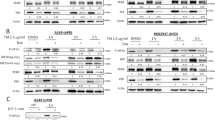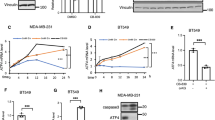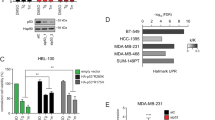Abstract
To proliferate and expand in an environment with limited nutrients, cancer cells co-opt cellular regulatory pathways that facilitate adaptation and thereby maintain tumor growth and survival potential. The endoplasmic reticulum (ER) is uniquely positioned to sense nutrient deprivation stress and subsequently engage signaling pathways that promote adaptive strategies. As such, components of the ER stress-signaling pathway represent potential antineoplastic targets. However, recent investigations into the role of the ER resident protein kinase, RNA-dependent protein kinase (PKR)-like ER kinase (PERK) have paradoxically suggested both pro- and anti-tumorigenic properties. We have used animal models of mammary carcinoma to interrogate the contribution of PERK in the neoplastic process. The ablation of PERK in tumor cells resulted in impaired regeneration of intracellular antioxidants and accumulation of reactive oxygen species triggering oxidative DNA damage. Ultimately, PERK deficiency impeded progression through the cell cycle because of the activation of the DNA damage checkpoint. Our data reveal that PERK-dependent signaling is used during both tumor initiation and expansion to maintain redox homeostasis, thereby facilitating tumor growth.
This is a preview of subscription content, access via your institution
Access options
Subscribe to this journal
Receive 50 print issues and online access
$259.00 per year
only $5.18 per issue
Buy this article
- Purchase on Springer Link
- Instant access to full article PDF
Prices may be subject to local taxes which are calculated during checkout








Similar content being viewed by others
References
Alam J, Stewart D, Touchard C, Boinapally S, Choi AM, Cook JL . (1999). Nrf2, a cabyp‘n’collar transcription factor, regulates induction of the heme oxygenase-1 gene. J Biol Chem 274: 26071–26078.
Back SH, Scheuner D, Han J, Song B, Ribick M, Wang J et al. (2009). Translation attenuation through eIF2alpha phosphorylation prevents oxidative stress and maintains the differentiated state in beta cells. Cell Metab 10: 13–26.
Bartkova J, Horejsí Z, Koed K, Kramer A, Tort F, Zieger K et al. (2005). DNA damage response as a candidate anti-cancer barrier in early human tumorigenesis. Nature 434: 864–870.
Bassing CH, Alt FW . (2004). H2AX may function as an anchor to hold broken chromosomal DNA ends in close proximity. Cell Cycle 3: 149–153.
Behrend L, Henderson G, Zwacka RM . (2003). Reactive oxygen species in oncogenic transformation. Biochem Soc Trans 31: 1441–1444.
Bi M, Naczki C, Koritzinsky M, Fels D, Blais J, Hu N et al. (2005). ER stress-regulated translation increases tolerance to extreme hypoxia and promotes tumor growth. EMBO J 24: 3470–3481.
Blais JD, Addison CL, Edge R, Falls T, Zhao H, Wary K et al. (2006). Perk-dependent translational regulation promotes tumor cell adaptation and angiogenesis in response to hypoxic stress. Mol Cell Biol 26: 9517–9532.
Bobrovnikova-Marjon E, Hatzivassiliou G, Grigoriadou C, Romero M, Cavener DR, Thompson CB et al. (2008). PERK-dependent regulation of lipogenesis during mouse mammary gland development and adipocyte differentiation. Proc Natl Acad Sci USA 105: 16314–16319.
Brewer JW, Diehl JA . (2000). PERK mediates cell-cycle exit during the mammalian unfolded protein response. Proc Natl Acad Sci USA 97: 12625–12630.
Brunelle JK, Bell EL, Quesada NM, Vercauteren K, Tiranti V, Zeviani M et al. (2005). Oxygen sensing requires mitochondrial ROS but not oxidative phosphorylation. Cell Metab 1: 409–414.
Bruns CJ, Koehl GE, Guba M, Yezhelyev M, Steinbauer M, Seeliger H et al. (2004). Rapamycin-induced endothelial cell death and tumor vessel thrombosis potentiate cytotoxic therapy against pancreatic cancer. Clin Cancer Res 10: 2109–2119.
Buetler TM, Gallagher EP, Wang C, Stahl DL, Hayes JD, Eaton DL . (1995). Induction of phase I and phase II drug-metabolizing enzyme mRNA, protein, and activity by BHA, ethoxyquin, and oltipraz. Toxicol Appl Pharmacol 135: 45–57.
Clanton TL . (2007). Hypoxia-induced reactive oxygen species formation in skeletal muscle. J Appl Physiol 102: 2379–2388.
Cullinan SB, Diehl JA . (2004). PERK-dependent activation of Nrf2 contributes to redox homeostasis and cell survival following ER stress. J Biol Chem 279: 20076–20087.
Cullinan SB, Gordan JD, Jin J, Harper JW, Diehl JA . (2004). The Keap1-BTB protein is an adaptor that bridges Nrf2 to a Cul3-based E3 ligase: oxidative stress sensing by a Cul3-Keap1 ligase. Mol Cell Biol 24: 8477–8486.
Cullinan SB, Zhang D, Hannink M, Arvisais E, Kaufman RJ, Diehl JA . (2003). Nrf2 is a direct PERK substrate and effector of PERK-dependent cell survival. Mol Cell Biol 23: 7198–7209.
Daneshmand S, Quek ML, Lin E, Lee C, Cote RJ, Hawes D et al. (2007). Glucose-regulated protein GRP78 is up-regulated in prostate cancer and correlates with recurrence and survival. Hum Pathol 38: 1547–1552.
DeBerardinis RJ, Lum JJ, Hatzivassiliou G, Thompson CB . (2008). The biology of cancer: metabolic reprogramming fuels cell growth and proliferation. Cell Metab 7: 11–20.
Denoyelle C, Abou-Rjaily G, Bezrookove V, Verhaegen M, Johnson TM, Fullen DR et al. (2006). Anti-oncogenic role of the endoplasmic reticulum differentially activated by mutations in the MAPK pathway. Nat Cell Biol 8: 1053–1063.
Evans KL . (2000). Overexpression of CDC25A associated with poor prognosis in breast cancer. Mol Med Today 6: 459.
Fernandez PM, Tabbara SO, Jacobs LK, Manning FC, Tsangaris TN, Schwartz AM et al. (2000). Overexpression of the glucose-regulated stress gene GRP78 in malignant but not benign human breast lesions. Breast Cancer Res Treat 59: 15–26.
Folkman J, Cole P, Zimmerman S . (1966). Tumor behavior in isolated perfused organs: in vitro growth and metastases of biopsy material in rabbit thyroid and canine intestinal segment. Ann Surg 164: 491–502.
Frohlich DA, McCabe MT, Arnold RS, Day ML . (2008). The role of Nrf2 in increased reactive oxygen species and DNA damage in prostate tumorigenesis. Oncogene 27: 4353–4362.
Furukawa M, He YJ, Borchers C, Xiong Y . (2003). Targeting of protein ubiquitination by BTB-Cullin 3-Roc1 ubiquitin ligases. Nat Cell Biol 5: 1001–1007.
Furukawa M, Xiong Y . (2005). BTB protein Keap1 targets antioxidant transcription factor Nrf2 for ubiquitination by the Cullin 3-Roc1 ligase. Mol Cell Biol 25: 162–171.
Gazit G, Lu J, Lee AS . (1999). De-regulation of GRP stress protein expression in human breast cancer cell lines. Breast Cancer Res Treat 54: 135–146.
Gorgoulis VG, Vassiliou LV, Karakaidos P, Zacharatos P, Kotsinas A, Liloglou T et al. (2005). Activation of the DNA damage checkpoint and genomic instability in human precancerous lesions. Nature 434: 907–913.
Guy CT, Webster MA, Schaller M, Parsons TJ, Cardiff RD, Muller WJ . (1992). Expression of the neu protooncogene in the mammary epithelium of transgenic mice induces metastatic disease. Proc Natl Acad Sci USA 89: 10578–10582.
Guzy RD, Hoyos B, Robin E, Chen H, Liu L, Mansfield KD et al. (2005). Mitochondrial complex III is required for hypoxia-induced ROS production and cellular oxygen sensing. Cell Metab 1: 401–408.
Guzy RD, Schumacker PT . (2006). Oxygen sensing by mitochondria at complex III: the paradox of increased reactive oxygen species during hypoxia. Exp Physiol 91: 807–819.
Harding HP, Zhang Y, Bertolotti A, Zeng H, Ron D . (2000). Perk is essential for translational regulation and cell survival during the unfolded protein response. Mol Cell 5: 897–904.
Harding HP, Zhang Y, Ron D . (1999). Protein translation and folding are coupled by an endoplasmic-reticulum-resident kinase. Nature 397: 271–274.
Harding HP, Zhang Y, Zeng H, Novoa I, Lu PD, Calfon M et al. (2003). An integrated stress response regulates amino acid metabolism and resistance to oxidative stress. Mol Cell 11: 619–633.
Hayes JD, Chanas SA, Henderson CJ, McMahon M, Sun C, Moffat GJ et al. (2000). The Nrf2 transcription factor contributes both to the basal expression of glutathione S-transferases in mouse liver and to their induction by the chemopreventive synthetic antioxidants, butylated hydroxyanisole and ethoxyquin. Biochem Soc Trans 28: 33–41.
Haze K, Yoshida H, Yanagi H, Yura T, Mori K . (1999). Mammalian transcription factor ATF6 is synthesized as a transmembrane protein and activated by proteolysis in response to endoplasmic reticulum stress. Mol Biol Cell 10: 3787–3799.
Huang HC, Nguyen T, Pickett CB . (2002). Phosphorylation of Nrf2 at Ser-40 by protein kinase C regulates antioxidant response element-mediated transcription. J Biol Chem 277: 42769–42774.
Itoh K, Chiba T, Takahashi S, Ishii T, Igarashi K, Katoh Y et al. (1997). An Nrf2/small Maf heterodimer mediates the induction of phase II detoxifying enzyme genes through antioxidant response elements. Biochem Biophys Res Commun 236: 313–322.
Kim WJ, Vo QN, Shrivastav M, Lataxes TA, Brown KD . (2002). Aberrant methylation of the ATM promoter correlates with increased radiosensitivity in a human colorectal tumor cell line. Oncogene 21: 3864–3871.
Kobayashi A, Kang MI, Okawa H, Ohtsuji M, Zenke Y, Chiba T et al. (2004). Oxidative stress sensor Keap1 functions as an adaptor for Cul3-based E3 ligase to regulate proteasomal degradation of Nrf2. Mol Cell Biol 24: 7130–7139.
Lee HK, Xiang C, Cazacu S, Finniss S, Kazimirsky G, Lemke N et al. (2008). GRP78 is overexpressed in glioblastomas and regulates glioma cell growth and apoptosis. Neuro Oncol 10: 236–243.
Li M, Baumeister P, Roy B, Phan T, Foti D, Luo S et al. (2000). ATF6 as a transcription activator of the endoplasmic reticulum stress element: thapsigargin stress-induced changes and synergistic interactions with NF-Y and YY1. Mol Cell Biol 20: 5096–5106.
Lin DI, Lessie MD, Gladden AB, Bassing CH, Wagner KU, Diehl JA . (2008). Disruption of cyclin D1 nuclear export and proteolysis accelerates mammary carcinogenesis. Oncogene 27: 1231–1242.
Liu L, Wise DR, Diehl JA, Simon MC . (2008). Hypoxic reactive oxygen species regulate the integrated stress response and cell survival. J Biol Chem 283: 31153–31162.
Lo SC, Li X, Henzl MT, Beamer LJ, Hannink M . (2006). Structure of the Keap1:Nrf2 interface provides mechanistic insight into Nrf2 signaling. EMBO J 25: 3605–3617.
Nicco C, Laurent A, Chereau C, Weill B, Batteux F . (2005). Differential modulation of normal and tumor cell proliferation by reactive oxygen species. Biomed Pharmacother 59: 169–174.
Nioi P, Nguyen T . (2007). A mutation of Keap1 found in breast cancer impairs its ability to repress Nrf2 activity. Biochem Biophys Res Commun 362: 816–821.
Ohta T, Iijima K, Miyamoto M, Nakahara I, Tanaka H, Ohtsuji M et al. (2008). Loss of Keap1 function activates Nrf2 and provides advantages for lung cancer cell growth. Cancer Res 68: 1303–1309.
Ranganathan AC, Ojha S, Kourtidis A, Conklin DS, Aguirre-Ghiso JA . (2008). Dual function of pancreatic endoplasmic reticulum kinase in tumor cell growth arrest and survival. Cancer Res 68: 3260–3268.
Reddy NM, Kleeberger SR, Bream JH, Fallon PG, Kensler TW, Yamamoto M et al. (2008). Genetic disruption of the Nrf2 compromises cell-cycle progression by impairing GSH-induced redox signaling. Oncogene 27: 5821–5832.
Sequeira SJ, Ranganathan AC, Adam AP, Iglesias BV, Farias EF, Aguirre-Ghiso JA . (2007). Inhibition of proliferation by PERK regulates mammary acinar morphogenesis and tumor formation. PLoS ONE 2: e615.
Shenvi SV, Smith EJ, Hagen TM . (2009). Transcriptional regulation of rat gamma-glutamate cysteine ligase catalytic subunit gene is mediated through a distal antioxidant response element. Pharmacol Res 60: 229–236.
Shi Y, Vattem KM, Sood R, An J, Liang J, Stramm L et al. (1998). Identification and characterization of pancreatic eukaryotic initiation factor 2 alpha-subunit kinase, PEK, involved in translational control. Mol Cell Biol 18: 7499–7509.
Shibata T, Ohta T, Tong KI, Kokubu A, Odogawa R, Tsuta K et al. (2008). Cancer related mutations in NRF2 impair its recognition by Keap1-Cul3 E3 ligase and promote malignancy. Proc Natl Acad Sci USA 105: 13568–13573.
Shimizu Y, Hendershot LM . (2009). Oxidative folding: cellular strategies for dealing with the resultant equimolar production of reactive oxygen species. Antioxid Redox Signal 11: 2317–2331.
Singh A, Boldin-Adamsky S, Thimmulappa RK, Rath SK, Ashush H, Coulter J et al. (2008). RNAi-mediated silencing of nuclear factor erythroid-2-related factor 2 gene expression in non-small cell lung cancer inhibits tumor growth and increases efficacy of chemotherapy. Cancer Res 68: 7975–7984.
Spitz DR, Sim JE, Ridnour LA, Galoforo SS, Lee YJ . (2000). Glucose deprivation-induced oxidative stress in human tumor cells. A fundamental defect in metabolism? Ann NY Acad Sci 899: 349–362.
Stracker TH, Couto SS, Cordon-Cardo C, Matos T, Petrini JH . (2008). Chk2 suppresses the oncogenic potential of DNA replication-associated DNA damage. Mol Cell 31: 21–32.
Tirasophon W, Welihinda AA, Kaufman RJ . (1998). A stress response pathway from the endoplasmic reticulum to the nucleus requires a novel bifunctional protein kinase/endoribonuclease (Ire1p) in mammalian cells. Genes Dev 12: 1812–1824.
Tommiska J, Bartkova J, Heinonen M, Hautala L, Kilpivaara O, Eerola H et al. (2008). The DNA damage signalling kinase ATM is aberrantly reduced or lost in BRCA1/BRCA2-deficient and ER/PR/ERBB2-triple-negative breast cancer. Oncogene 27: 2501–2506.
Vattem KM, Wek RC . (2004). Reinitiation involving upstream ORFs regulates ATF4 mRNA translation in mammalian cells. Proc Natl Acad Sci USA 101: 11269–11274.
Wang XZ, Harding HP, Zhang Y, Jolicoeur EM, Kuroda M, Ron D . (1998). Cloning of mammalian Ire1 reveals diversity in the ER stress responses. EMBO J 17: 5708–5717.
Wang Y, Shen J, Arenzana N, Tirasophon W, Kaufman RJ, Prywes R . (2000). Activation of ATF6 and an ATF6 DNA binding site by the endoplasmic reticulum stress response. J Biol Chem 275: 27013–27020.
Wei J, Sheng X, Feng D, McGrath B, Cavener DR . (2008). PERK is essential for neonatal skeletal development to regulate osteoblast proliferation and differentiation. J Cell Physiol 217: 693–707.
Wild AC, Moinova HR, Mulcahy RT . (1999). Regulation of gamma-glutamylcysteine synthetase subunit gene expression by the transcription factor Nrf2. J Biol Chem 274: 33627–33636.
Wild AC, Mulcahy RT . (2000). Regulation of gamma-glutamylcysteine synthetase subunit gene expression: insights into transcriptional control of antioxidant defenses. Free Radic Res 32: 281–301.
Wu J, Rutkowski DT, Dubois M, Swathirajan J, Saunders T, Wang J et al. (2007). ATF6alpha optimizes long-term endoplasmic reticulum function to protect cells from chronic stress. Dev Cell 13: 351–364.
Wu W, Fan YH, Kemp BL, Walsh G, Mao L . (1998). Overexpression of cdc25A and cdc25B is frequent in primary non-small cell lung cancer but is not associated with overexpression of c-myc. Cancer Res 58: 4082–4085.
Wu X, Webster SR, Chen J . (2001). Characterization of tumor-associated Chk2 mutations. J Biol Chem 276: 2971–2974.
Yamamoto K, Sato T, Matsui T, Sato M, Okada T, Yoshida H et al. (2007). Transcriptional induction of mammalian ER quality control proteins is mediated by single or combined action of ATF6alpha and XBP1. Dev Cell 13: 365–376.
Zhang DD, Lo SC, Cross JV, Templeton DJ, Hannink M . (2004). Keap1 is a redox-regulated substrate adaptor protein for a Cul3-dependent ubiquitin ligase complex. Mol Cell Biol 24: 10941–10953.
Zhang F, Hamanaka RB, Bobrovnikova-Marjon E, Gordan JD, Dai MS, Lu H et al. (2006a). Ribosomal stress couples the unfolded protein response to p53-dependent cell cycle arrest. J Biol Chem 281: 30036–30045.
Zhang W, Feng D, Li Y, Iida K, McGrath B, Cavener DR . (2006b). PERK EIF2AK3 control of pancreatic beta cell differentiation and proliferation is required for postnatal glucose homeostasis. Cell Metab 4: 491–497.
Zhang YW, Brognard J, Coughlin C, You Z, Dolled-Filhart M, Aslanian A et al. (2009). The F box protein Fbx6 regulates Chk1 stability and cellular sensitivity to replication stress. Mol Cell 35: 442–453.
Zhang YW, Otterness DM, Chiang GG, Xie W, Liu YC, Mercurio F et al. (2005). Genotoxic stress targets human Chk1 for degradation by the ubiquitin-proteasome pathway. Mol Cell 19: 607–618.
Acknowledgements
We thank Serge Fuchs for critical reading of the paper, Margarita Romero for outstanding technical assistance and the AFCRI histology core. This work was supported by the National Institutes of Health Grants F32CA1238252 (to EBM), P01 CA104838 and a Leukemia & Lymphoma Scholar award (to JAD).
Author information
Authors and Affiliations
Corresponding author
Ethics declarations
Competing interests
The authors declare no conflict of interest.
Additional information
Supplementary Information accompanies the paper on the Oncogene website
Supplementary information
Rights and permissions
About this article
Cite this article
Bobrovnikova-Marjon, E., Grigoriadou, C., Pytel, D. et al. PERK promotes cancer cell proliferation and tumor growth by limiting oxidative DNA damage. Oncogene 29, 3881–3895 (2010). https://doi.org/10.1038/onc.2010.153
Received:
Revised:
Accepted:
Published:
Issue Date:
DOI: https://doi.org/10.1038/onc.2010.153
Keywords
This article is cited by
-
Synergistic lethality in chronic myeloid leukemia – targeting oxidative phosphorylation and unfolded protein response effectively complements tyrosine kinase inhibitor treatment
BMC Cancer (2023)
-
Intratumoral microbiota: roles in cancer initiation, development and therapeutic efficacy
Signal Transduction and Targeted Therapy (2023)
-
SMURF1 attenuates endoplasmic reticulum stress by promoting the degradation of KEAP1 to activate NRF2 antioxidant pathway
Cell Death & Disease (2023)
-
Runx1/3-driven adaptive endoplasmic reticulum stress pathways contribute to neurofibromagenesis
Oncogene (2023)
-
Interleukin-1 alpha and high mobility group box-1 secretion in polyinosinic:polycytidylic-induced colorectal cancer cells occur via RIPK1-dependent mechanism and participate in tumourigenesis
Journal of Cell Communication and Signaling (2023)



